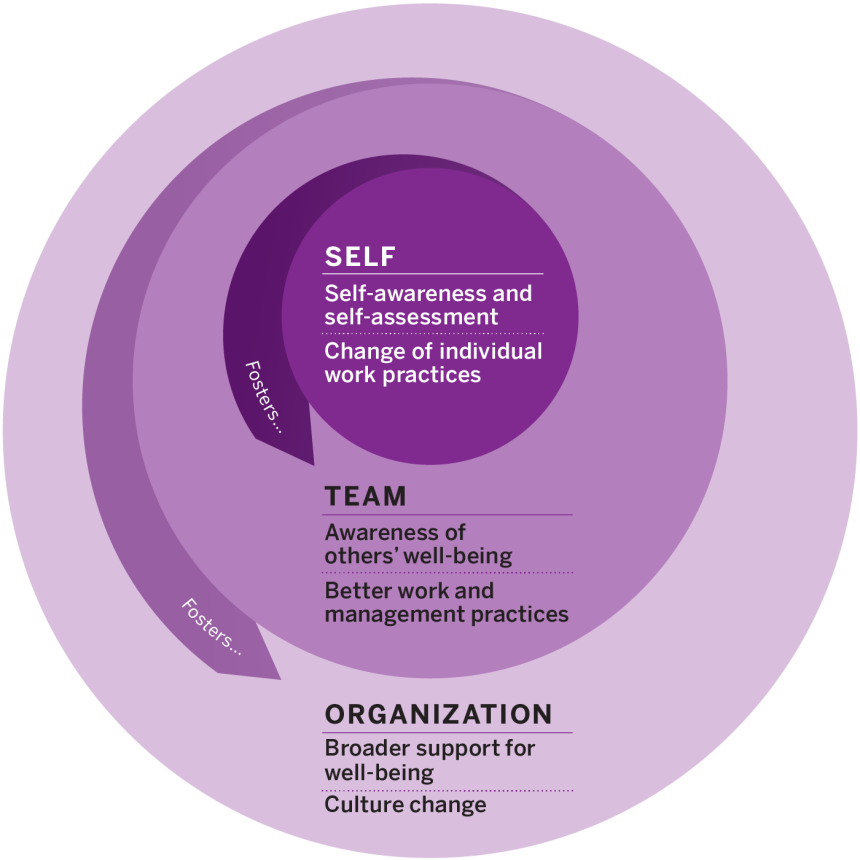Well-Being Intelligence: A Skill Set for the New World of Work
A rise in workplace mental health issues calls for an informed response from managers and organizations.
News
- Identity-based Attacks Account for 60% of Leading Cyber Threats, Report Finds
- CERN and Pure Storage Partner to Power Data Innovation in High-Energy Physics
- CyberArk Launches New Machine Identity Security Platform to Protect Cloud Workloads
- Why Cloud Security Is Breaking — And How Leaders Can Fix It
- IBM z17 Mainframe to Power AI Adoption at Scale
- Global GenAI Spending to Hit $644 Billion by 2025, Gartner Projects

The rise in the number of sick days employees have been taking is becoming a concern in many developed countries. In Sweden, the number of sick days per employee increased by one full day per year from 2021 to 2022. In the U.S., the absenteeism rate is the highest it has been in a decade; in December 2022 alone, an estimated 1.5 million Americans missed work.
While ongoing waves of COVID-19 infections have played a role in absenteeism, there is also evidence of a rise in mental health issues, which were responsible for 20% of the sick days used in France in 2022 — an increase from 17% in 2021 and 15% in 2020. For the National Health Service in the U.K., the cost of sick days related to mental health issues has doubled since the start of the pandemic, totaling nearly half a billion annually.
There are many overlapping explanations for such an apparent decrease in well-being at work. Most obviously, we are emerging from a global pandemic that has required both organizations and employees to be resilient in the face of stressful work conditions on top of health and family concerns. Add a cost-of-living crisis, and it’s clear that anxiety is beginning to dominate our experience of work. Further, when colleagues go missing due to illness or poor mental health, it can create a domino effect, as those left behind have to take on additional responsibilities in the short term.
Many organizations, including Vitality, Salesforce, and Infosys, have designed what we call organizational strategies for well-being, through initiatives such as reshaping their culture and providing direct well-being benefits. These shifts may involve training leaders on well-being, offering benefits such as meditation or well-being apps, or providing access to counseling.
The trend of increasing sick-day use and mental health issues calls for a focus on such well-being initiatives in the workplace. We propose the concept of well-being intelligence for managers as a skill set and tool to understand and improve their own and employees’ well-being. As workplace challenges increase, well-being intelligence is becoming an essential leadership skill. Effective managers must be able to detect when others are struggling with well-being and know when and how to offer support.
Many people are familiar with the concept of emotional intelligence — how people understand their own emotions, regulate them, and approach the emotions of others — popularized by Dan Goleman in his 1995 book on the subject. Although emotions and well-being are interconnected, they differ in definition and in their impact on work. Emotions are more diffuse, and their effect on work is less direct than that of well-being. We can experience a great range of emotions over a short period of time, with our moods shifting depending on the context, people around us, or our own thoughts. Well-being, however, is a longer-term state that influences behavior and interactions in the workplace and beyond.
The Circles of Well-Being Intelligence
When leaders acknowledge the prevalence of mental health challenges in the workplace, they can shift the culture and raise awareness of this pressing concern. Leaders at all levels can be depressed, anxious, and stressed at work, but by recognizing and addressing the root causes, they can demonstrate a commitment to supporting the well-being of themselves and others.
The model below summarizes the core skill sets of well-being intelligence: identifying core mental health challenges, such as stress and anxiety; acknowledging their root causes; and designing approaches to address them at the individual, team, and organizational levels. (See “The Overlapping Circles of Well-Being Intelligence.”) Building self-awareness of one’s well-being is the first step. Self-awareness allows individuals to understand their thoughts, feelings, and behaviors, and adjust individual work practices accordingly for self-care.
The Overlapping Circles of Well-Being Intelligence

Actions taken to address well-being issues at the individual and team levels can drive broader organizational change.
Understanding our own well-being helps us to understand and explain how others’ well-being can also be affected, detect the challenges they face, and act upon those issues and our own (which may be the same). In turn, observing and acting on well-being will enable learning from experience, ultimately helping managers to implement changes at the team level. This in turn will broaden the support for well-being and encourage the development of positive norms throughout the organization.
Well-Being Intelligence in Practice
Applying well-being intelligence in practice requires a dedicated effort and a shift in behavior on three levels.
1. Prioritizing individual well-being. A manager’s first step to growing their well-being intelligence is to look inward to recognize their own mental health challenges at work and pinpoint their sources. Without the ability to comprehend what affects our own mental health and what challenges we are experiencing, our potential to address others’ issues is limited. To be attentive, thoughtful, resilient, and collaborative, managers must first focus on their own well-being and take the following steps.
- Continually self-assess their own mental health. In this first step, we reflect on our experiences at work and identify how they impact our well-being, positively or negatively. Is stress currently driven by specific interactions at work or specific periods, such as budget deadlines? Or is it the experience of a lingering sense of dread — typical of anxiety — when going to work? Well-being intelligence requires self-reflection on an ongoing basis rather than dismissing one’s needs until they grow too severe to ignore.
- Make concrete changes in their own approach to work. Self-analysis enables leaders to make changes to work practices or structures that address challenges. For example, we found that in the context of hybrid work, when an abundance of meetings was causing increased stress levels, senior executives’ well-being benefited most from focus hours. In the wake of stress, managers can revisit their time management at work and reallocate tasks to protect their own focus time. Managers who are well-being intelligent are also likely to protect their time off, which is known to prevent burnout.
2. Improving team well-being. While self-assessment is essential for well-being intelligence, issues faced by one individual are likely to be experienced by others on the team. Therefore, a personal knowledge and understanding of these issues can help in addressing them collectively by taking the following steps.
- Assess team members’ well-being. Conducting brief pulse surveys is a good way to get anonymized data on employees’ mental health because it enables people to report issues discretely. At a more personal level, when trust has been established, annual review meetings or even informal chats can be useful tools to assess the well-being challenges employees are facing. The information gathered from these efforts can be assessed and addressed by managers who have built an understanding of how and why challenges similar to their own might affect employees. If they observe well-being challenges among their colleagues that differ from their own, the experience of having learned and addressed their own issues will likely have taught them how to develop a systematic approach to disentangling well-being issues from their root causes.
- Improve work practices. The information gathered from assessments can provide evidence and momentum to change organizational practices, and the process itself creates awareness and acceptance of mental health issues more generally. At the managerial level, small changes matter; enforcing limited working hours, encouraging a healthy work-life balance, or setting up dedicated breaks and meeting-free days can make a significant difference to team members. Inviting struggling employees to ask for support within their team or from their managers will improve well-being both directly and indirectly by reducing the shame and stigma often associated with mental health challenges.
3. Fostering systemic change. Understanding and prioritizing individual and team well-being can trigger broader change and inspire new approaches in organizations.
- Broaden organizational support for well-being. Some issues of well-being will require higher-level support than an individual manager can accommodate. Organizational policies regarding flexible work arrangements or time off are crucial to ensure that employees can preserve strong boundaries between their professional and personal selves. If workload is a major issue, improving job design by redistributing tasks or considering ways to increase staffing or support in dedicated areas of the organization can help.
- Change organizational norms. Some organizational norms — such as the way feedback is provided, management communication styles (particularly if managers communicate after work hours), or attitudes toward taking sick days — can trigger well-being issues. Identifying and addressing these norms at the individual and team levels can help shift those well-anchored practices. Highlighting the consequences of such negative norms and incentivizing good practices around feedback, communication, and workplace interactions can drive long-lasting change.
Developing Well-Being Intelligence
Well-being intelligence is not an innate skill, and learning, exploring, and evaluating potential solutions to mental health-related issues requires conscious effort. Evaluating whether changes have successfully improved well-being can help managers determine whether the initial diagnosis of the issue was accurate or whether an alternative approach would be more effective. This approach relies on continually collecting feedback from employees, through formal and anonymous surveys or more informal one-on-one conversations. More tangible variables, such as turnover or an increased use of sick days, are also obvious markers of ongoing problems.
Well-being issues may take time to emerge and to solve as managers fine-tune changes. Well-being intelligence involves finding out how changes at work affect well-being and modifying those approaches to ensure their efficacy. Moreover, raising awareness of those issues and building a coalition within the organization is crucial for spearheading change.
Companies may also consider providing adapted training to employees on detecting mental health issues, including recognizing the signs and symptoms of stress, anxiety, or depression. Stress and anxiety are often confused — because they frequently appear concurrently — but anxiety is seen as persistent apprehension and overwhelming worry, whereas stress is a short-term state usually caused by an external factor such as a tight deadline or a meeting with a particularly intimidating colleague. Burnout is often the result of prolonged and unaddressed stress; identifying issues as they arise can help managers detect burnout and address the issue before it becomes critical.
One ongoing challenge to learning and developing well-being intelligence is the shift to hybrid work. Detecting well-being issues through screen- or audio-mediated interactions is more challenging. Signs of stress or anxiety that are visible in face-to-face interactions may be much harder to discern in a remote context. Managers may have to rely on tone of voice, silences in conversations, or speech rate rather than typical nonverbal cues to detect stress or anxiety among colleagues. Behavioral cues, such as struggling to maintain workload, isolating from team members in meetings, arriving late, or missing deadlines, can also indicate poor well-being.
Well-being intelligence will thus also require ability to lead tactful discussions on mental health in the context of online communication. Building trust during in-person interactions can facilitate open-hearted online exchanges. For fully remote organizations, integrating well-being discussions into annual reviews and starting remote team meetings with a quick round of well-being reports can be a simple way to demonstrate that employees’ well-being matters.
The pandemic has made it clear that investing in well-being intelligence is no longer optional; it’s essential for both the well-being of employees and the success of organizations. It’s not far-fetched to imagine a future where managers are routinely asked about their own mental health practices and the measures they have taken to promote the well-being of team members. Organizations that promote well-being intelligence don’t just create a healthier and more productive workforce; they build a competitive advantage for the future.





